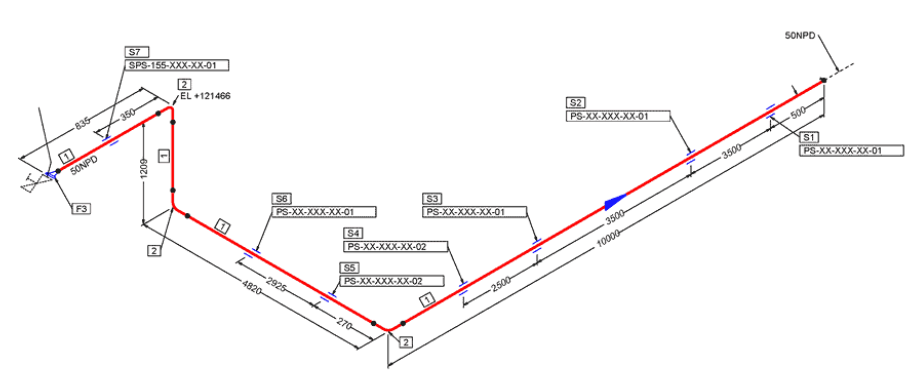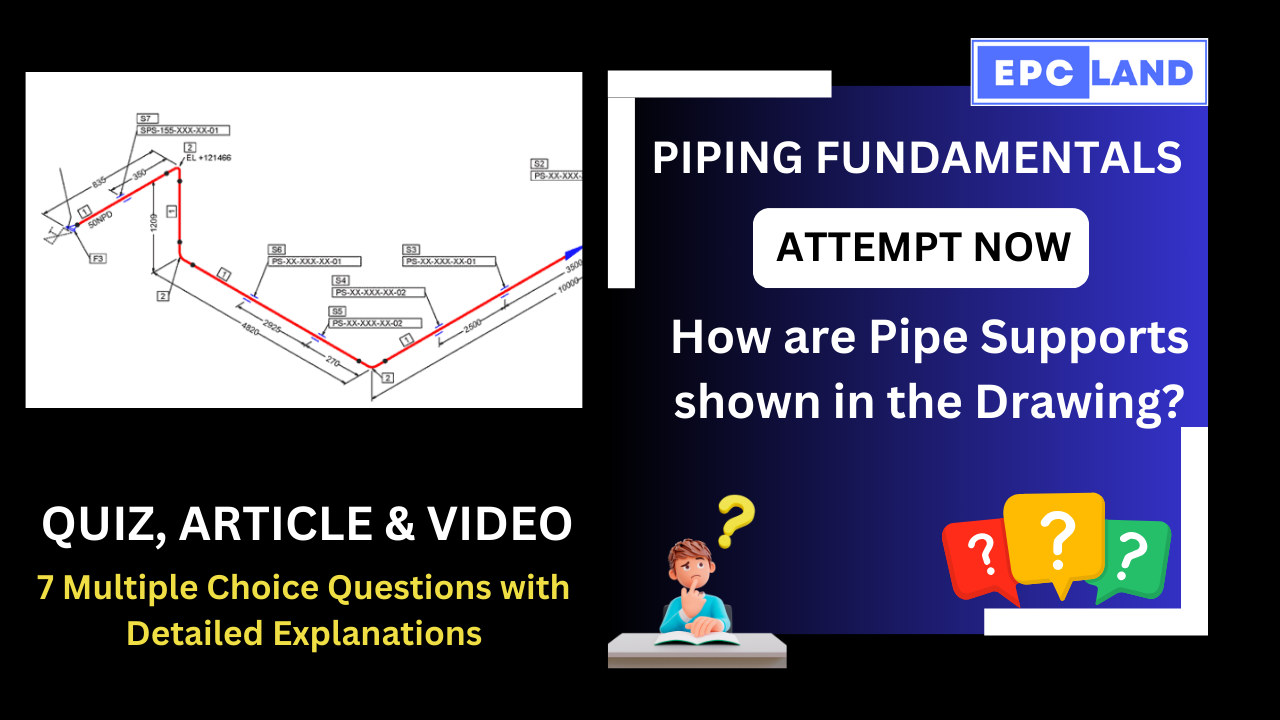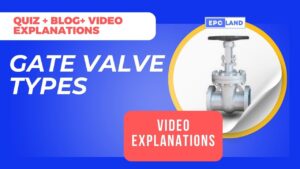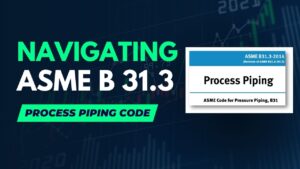
1. What does a pipe support call out on an isometric drawing typically consist of?
Choose the correct description for a pipe support call out.
Explanation: A pipe support call out on an isometric drawing typically consists of letters and numbers indicating the type of support to be welded to the pipe.
2. What is the starting prefix for call outs of special pipe supports on isometric drawings?
Identify the correct starting prefix for special pipe support call outs.
Explanation: Special pipe supports on isometric drawings have a starting prefix of “SPS” in their call outs.
3. Where are support call outs typically placed on an isometric drawing?
Choose the correct location for placing support call outs.
Explanation: Support call outs are typically placed near the pipe on the isometric drawing for clear representation.
4. What information may a single support call out represent?
Identify the correct statement about a single support call out.
Explanation: A single support call out may represent a combination of standard support types, such as clamps and wear pads.
5. How are special pipe supports indicated on an isometric drawing?
Choose the correct statement about the representation of special pipe supports.
Explanation: Special pipe supports are indicated with a separate “SPS” call out on the isometric drawing.
6. How are multiple pipes on a single support frame represented on isometric drawings?
Choose the correct statement about representing multiple pipes on a single support frame.
Explanation: If a single support frame supports multiple pipes, the call out is shown on only one isometric drawing, referencing others affected.
7. What are the benefits of clear pipe support call outs on isometric drawings?
Identify the correct statements about the benefits of clear call outs.
Explanation: Clear pipe support call outs ensure accurate interpretation during fabrication and installation, facilitate communication, and provide a clear reference point for future maintenance and inspection of the piping system.
Don’t Miss 20+ Quizzes on Pipe Supports:
Short Article on How are Pipe Supports shown in the Drawing?
Understanding Pipe Support Call Outs in Isometric Drawings
Pipe supports play a crucial role in piping systems, and their accurate representation on isometric drawings is essential for proper installation and maintenance. Here’s a breakdown of how pipe supports are typically shown in these drawings:
Pipe Support Call Out:
- Represented by a combination of letters and numbers.
- Indicates the type of support to be welded to the pipe.
- Standard support types like clamps, shoes, and trunnions have specific call out codes.
- Special pipe supports have unique call outs starting with “SPS” (Special Pipe Support).
Location and Combination:
- Support call outs are placed near the pipe on the isometric drawing.
- A single call out may represent a combination of standard support types.
- For example, a call out might include both a clamp and a wear pad.
Special Pipe Supports:
- Indicated with a separate “SPS” call out on the isometric drawing.
- Detailed information, including individual components, is provided on a dedicated special pipe support drawing.
- No support components are listed on the isometric drawing for special supports.
Multiple Pipes on a Single Support Frame:
- If a single support frame supports multiple pipes, the call out is only shown on one isometric drawing.
- For other affected lines, the drawing references the isometric drawing with the original call out.
Benefits of Clear Call Outs:
- Ensures accurate interpretation of support requirements during fabrication and installation.
- Facilitates easier communication and coordination between engineers, fabricators, and installers.
- Provides a clear reference point for future maintenance and inspection of the piping system.
Additional Notes:
- Isometric drawing standards and conventions may vary depending on industry regulations and project specifications.
- Consulting project-specific drawings and documentation is crucial for ensuring accurate interpretation of pipe support call outs.
By understanding how pipe supports are shown in isometric drawings, you can effectively interpret piping designs and ensure the successful implementation and maintenance of piping systems.
Table of Contents
Don’t miss the Course on Effective Isometrics Management: Check Now
Enrollment Link
Recommended courses (Published on EPCLand)
- Complete Course on Piping Engineering
- Basics of Piping Engineering
- Piping Layout Engineering
- Piping Material Engineering
- Piping Stress Analysis
- Material Requisitions
- Piping Material Specifications
- Valve Material Specifications
- Plant Design & Layouts-OISD 118
- Isometric Management
Library of Technical Articles
Don’t miss out the collection of 15+ articles on following topics:
- Basics of Oil and Gas Industry
- Valves
- Testing
- Tank
- Piping Bulk Items
- Pipe
- Metallurgy
- Piping Materials
- Layout
- Instrumentation
- Heat Exchanger
- Type of Contracts
- Codes and Standards
- ASTM Standards
- Articles on Piping Specialty Items
Video details of Complete Course on Piping Engineering
Why Enroll in the EPCLand
Proven Track Record– PTR
Activities & Achievements before launching EPCLand
- Published more than 50+ short courses
- 3000+ Enrolments
- More than 3,500,00 Minutes of watch hours in the last 2 years
- 4000+ Students in 100+ Countries
- Rating of 4+ out of 5
- 1000+ YouTube Videos
- 8K+ Subscribers
What Students will Learn
- Codes & Standards of the Energy Sector
- Piping Material Engineering
- Piping Layout Engineering
- Stress Analysis
Interesting facts
- All the published courses have been developed by Industry Experts with more than 2 decades of experience
- Content is based on Practical experience and real-time problems.
- Content is designed and organized in such a manner that it can be easily grabbed.
- Complete website, Blogs and Quiz sections are Planned, Designed and published by myself (About me: Atul Singla)
- Complete flexibility of Time & Location, Students can access the content from anywhere & anytime
- Moreover, once enrolled, the content can be access as many times as you want, which helps in understand the fundamentals in a better way.
Conclusion
In conclusion, our courses are meticulously crafted by industry experts with over two decades of hands-on experience. The content is rooted in practical knowledge, addressing real-time problems. The material is thoughtfully designed and organized for easy comprehension. Every aspect, from the website to blogs and quizzes, has been planned, designed, and executed by Atul Singla, ensuring a comprehensive and seamless learning experience. With the flexibility of accessing the content at any time and from any location, students have the freedom to learn on their terms. Furthermore, enrollment grants unlimited access, allowing learners to revisit the material as often as needed, fostering a deep understanding of the fundamentals.



